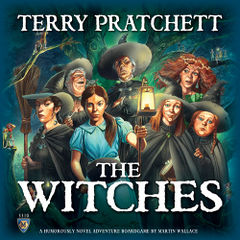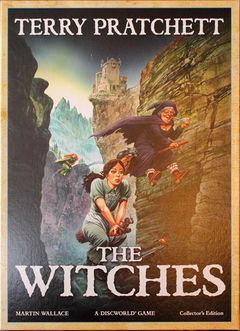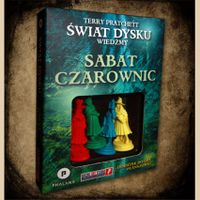Game:The Witches A Discworld Game: Difference between revisions
(Added further description of gameplay; removed whitespace) |
|||
| (2 intermediate revisions by the same user not shown) | |||
| Line 9: | Line 9: | ||
The game is “semi co-operative”, which means that the players can lose as a group, and so must co-operate to prevent crises from escalating. If they avoid that fate, they continue playing to the end, when one of them will win. | The game is “semi co-operative”, which means that the players can lose as a group, and so must co-operate to prevent crises from escalating. If they avoid that fate, they continue playing to the end, when one of them will win. | ||
Problems - divided into “easy” generic issues like fever, sick animals and pregnancies, and “hard” specific threats to Lancre, like elves, [[ | Problems - divided into “easy” generic issues like fever, sick animals and pregnancies, and “hard” specific threats to Lancre, like [[elves]], [[Leonal Felmet|Lord]] and [[Lady Felmet]], or the [[Hiver]] - are placed as tiles on the map. To solve them, a player must visit the location of a problem, then roll dice, hoping to beat the problem's difficulty number. Players roll two of the four dice before deciding if they will play cards from their hand (which represent various characters from the witches and Tiffany novels) to improve their result; they can also choose to run away, abandoning the problem. | ||
Points are scored based on the number and difficulty of problems solved. Those solved problems also represent experience, allowing a player to hold more cards in their hand to play when solving problems, and eventually to gain permanent bonuses to their dice rolls. Players can also accumulate “cackle tokens”, mostly by using magic to solve problems, or by rolling the cackle symbol (worth zero) on the dice. If they cackle too much, they may turn bad, requiring them to take a “[[Black Aliss]]” token which reduces their score. Players can visit other players on the board to “have tea”, allowing them to discard cackle tokens as they check in on each other, much as Nanny and Granny do. | Points are scored based on the number and difficulty of problems solved. Those solved problems also represent experience, allowing a player to hold more cards in their hand to play when solving problems, and eventually to gain permanent bonuses to their dice rolls. Players can also accumulate “cackle tokens”, mostly by using magic to solve problems, or by rolling the cackle symbol (worth zero) on the dice. If they cackle too much, they may turn bad, requiring them to take a “[[Black Aliss]]” token which reduces their score. Players can visit other players on the board to “have tea”, allowing them to discard cackle tokens as they check in on each other, much as Nanny and Granny do. | ||
| Line 15: | Line 15: | ||
== Collectors Edition == | == Collectors Edition == | ||
[[File:Witches Game Coll.jpg|thumb|right|240px|Collectors Box Art]] | [[File:Witches Game Coll.jpg|thumb|right|240px|Collectors Box Art]] | ||
A collectors edition of the game was also released featuring a larger game board, pewter sculpted playing pieces of the four witch apprentices, | A collectors edition of the game was also released featuring a larger game board, pewter sculpted playing pieces of the four witch apprentices (the standard edition has wooden witch’s hats in colours matching the character’s player boards), a cloth bag for the miniatures, and a poster of the game's artwork by artist Peter Dennis. | ||
== | ==Alternate Pieces== | ||
[[File:WitchGamePieces.jpg|thumb|left|200px|Extra Game Pieces]] | [[File:WitchGamePieces.jpg|thumb|left|200px|Extra Game Pieces]] | ||
A | A collection of alternate playing pieces was created by [[Micro Art Studios]] and marketed as a mini-expansion for the game, under the title ''Sabat Czarownic'’ (“Witches Sabbath”). These were sculpted playing pieces of the four playable witches. While similar in concept to the ones in the collectors edition, there are different sculpts, and made of resin in colours that match the original playing pieces and boards for each character. | ||
==External Links== | ==External Links== | ||
Latest revision as of 23:54, 3 June 2023

The Witches: A Discworld Game is the second game by Martin Wallace and Treefrog Games set in Terry Pratchett's Discworld, the first being Discworld: Ankh-Morpork.
The Witches is set in the magically charged land of Lancre. Up to four players take on the role of trainee witches, namely Tiffany Aching, Petulia Gristle, Annagramma Hawkin or Dimity Hubbub, learning their craft and dealing with all the problems, both petty and serious, that life on Discworld can throw at them.
A subtle blend of headology, magic and, of course, the all-important cup of tea will see our heroines tackle everything from a sick pig to a full-blown invasion of elves.
Gameplay
The game is “semi co-operative”, which means that the players can lose as a group, and so must co-operate to prevent crises from escalating. If they avoid that fate, they continue playing to the end, when one of them will win.
Problems - divided into “easy” generic issues like fever, sick animals and pregnancies, and “hard” specific threats to Lancre, like elves, Lord and Lady Felmet, or the Hiver - are placed as tiles on the map. To solve them, a player must visit the location of a problem, then roll dice, hoping to beat the problem's difficulty number. Players roll two of the four dice before deciding if they will play cards from their hand (which represent various characters from the witches and Tiffany novels) to improve their result; they can also choose to run away, abandoning the problem.
Points are scored based on the number and difficulty of problems solved. Those solved problems also represent experience, allowing a player to hold more cards in their hand to play when solving problems, and eventually to gain permanent bonuses to their dice rolls. Players can also accumulate “cackle tokens”, mostly by using magic to solve problems, or by rolling the cackle symbol (worth zero) on the dice. If they cackle too much, they may turn bad, requiring them to take a “Black Aliss” token which reduces their score. Players can visit other players on the board to “have tea”, allowing them to discard cackle tokens as they check in on each other, much as Nanny and Granny do.
Collectors Edition

A collectors edition of the game was also released featuring a larger game board, pewter sculpted playing pieces of the four witch apprentices (the standard edition has wooden witch’s hats in colours matching the character’s player boards), a cloth bag for the miniatures, and a poster of the game's artwork by artist Peter Dennis.
Alternate Pieces

A collection of alternate playing pieces was created by Micro Art Studios and marketed as a mini-expansion for the game, under the title Sabat Czarownic'’ (“Witches Sabbath”). These were sculpted playing pieces of the four playable witches. While similar in concept to the ones in the collectors edition, there are different sculpts, and made of resin in colours that match the original playing pieces and boards for each character.
External Links
- The Witches A Discworld Game on Board Game Geek
- Treefrog Games's Website